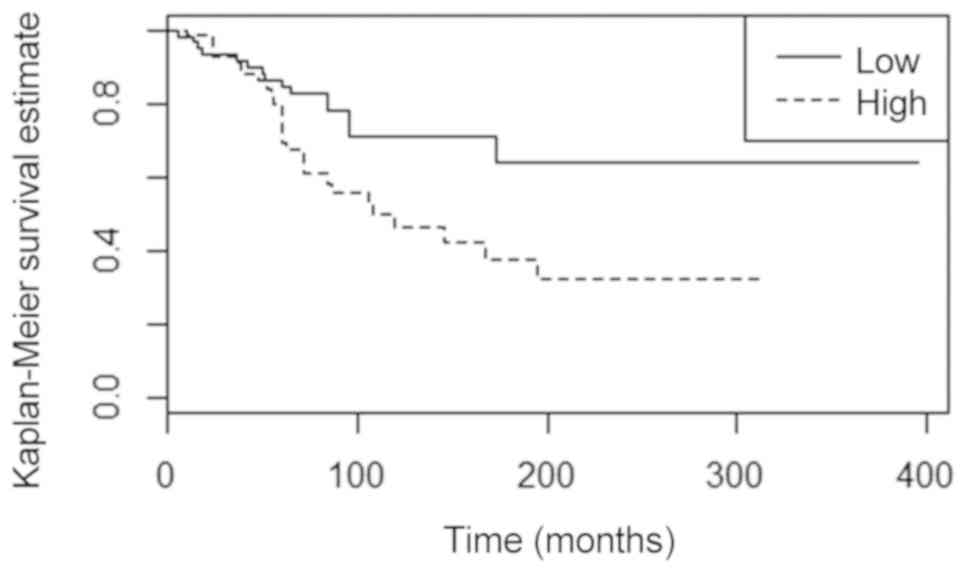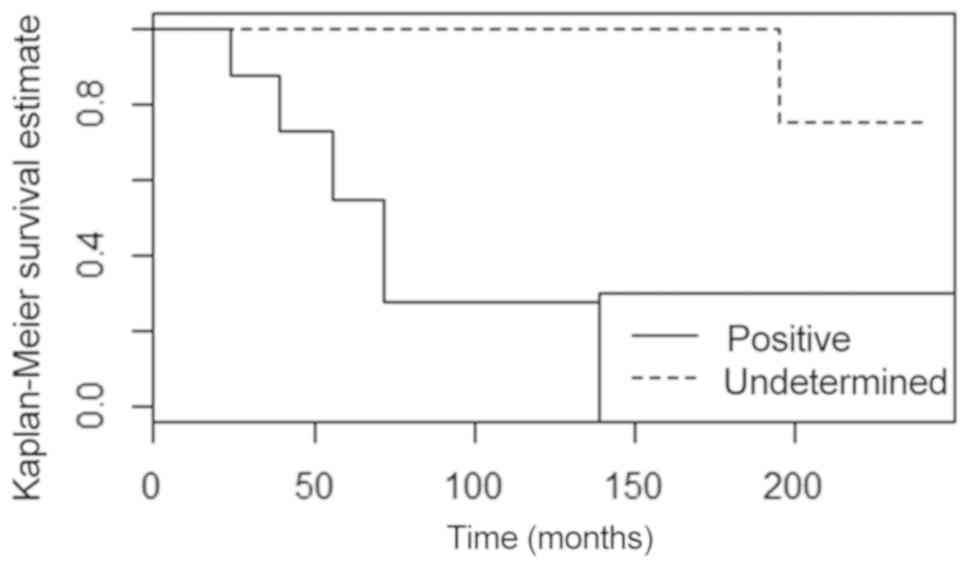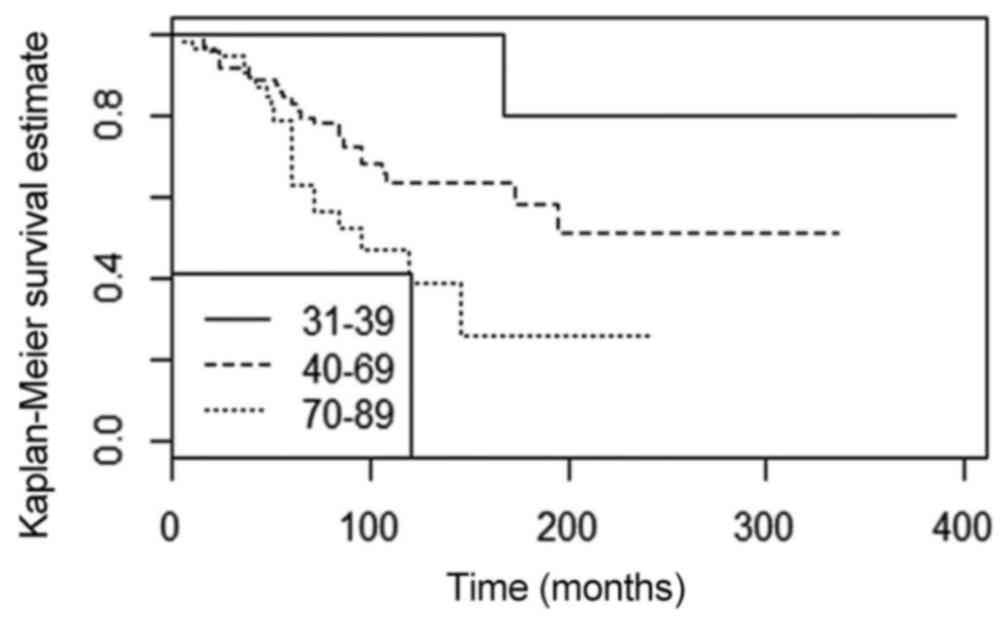|
1
|
Miao H, Verkooijen HM, Chia KS, Bouchardy
C, Pukkala E, Larønningen S, Mellemkjaer L, Czene K and Hartman M:
Incidence and outcome of male breast cancer: An international
population-based study. J Clin Oncol. 29:4381–4386. 2011.
View Article : Google Scholar : PubMed/NCBI
|
|
2
|
Speirs V and Shaaban AM: The rising
incidence of male breast cancer. Breast Cancer Res Treat.
115:429–430. 2009. View Article : Google Scholar : PubMed/NCBI
|
|
3
|
Ly D, Forman D, Ferlay J, Brinton LA and
Cook MB: An international comparison of male and female breast
cancer incidence rates. Int J Cancer. 132:1918–1926. 2013.
View Article : Google Scholar : PubMed/NCBI
|
|
4
|
White J, Kearins O, Dodwell D, Horgan K,
Hanby AM and Speirs V: Male breast carcinoma: Increased awareness
needed. Breast Cancer Res. 13:2192011. View
Article : Google Scholar : PubMed/NCBI
|
|
5
|
Yalaza M, İnan A and Bozer M: Male breast
cancer. J Breast Health. 12:1–8. 2016. View Article : Google Scholar : PubMed/NCBI
|
|
6
|
Leone JP, Zwenger AO, Iturbe J, Leone J,
Leone BA, Vallejo CT and Bhargava R: Prognostic factors in male
breast cancer: A population-based study. Breast Cancer Res Treat.
156:539–548. 2016. View Article : Google Scholar : PubMed/NCBI
|
|
7
|
Cardoso F, Bartlett JMS, Slaets L, van
Deurzen CHM, van Leeuwen-Stok E, Porter P, Linderholm B, Hedenfalk
I, Schröder C, Martens J, et al: Characterization of male breast
cancer: Results of the EORTC 10085/TBCRC/BIG/NABCG international
male breast cancer program. Ann Oncol. 29:405–417. 2018.PubMed/NCBI
|
|
8
|
Gargiulo P, Pensabene M, Milano M, Arpino
G, Giuliano M, Forestieri V, Condello C, Lauria R and De Placido S:
Long-term survival and BRCA status in male breast cancer: A
retrospective single-center analysis. BMC Cancer. 16:3752016.
View Article : Google Scholar : PubMed/NCBI
|
|
9
|
Anderson WF, Jatoi I, Tse J and Rosenberg
PS: Male breast cancer: A population-based comparison with female
breast cancer. J Clin Oncol. 28:232–239. 2010. View Article : Google Scholar : PubMed/NCBI
|
|
10
|
Miranda AC: National Oncological Registry
South (ROR-South) 2010–2011. Incidence. (Survival and Mortality for
cancer in the Southern region of Portugal - ISM2010/2011.
ROR-South. Portuguese Institute of Oncology of Lisbon). 2017.
|
|
11
|
Kreiter E, Richardson A, Potter J and
Yasui Y: Breast cancer: Trends in international incidence in men
and women. Br J Cancer. 110:1891–1897. 2014. View Article : Google Scholar : PubMed/NCBI
|
|
12
|
Ferzoco RM and Ruddy KJ: The epidemiology
of male breast cancer. Curr Oncol Rep. 18:12016. View Article : Google Scholar : PubMed/NCBI
|
|
13
|
Deb S, Lakhani SR, Ottini L and Fox SB:
The cancer genetics and pathology of male breast cancer.
Histopathology. 68:110–118. 2016. View Article : Google Scholar : PubMed/NCBI
|
|
14
|
Pritzlaff M, Summerour P, McFarland R, Li
S, Reineke P, Dolinsky JS, Goldgar DE, Shimelis H, Couch FJ, Chao
EC and LaDuca H: Male breast cancer in a multi-gene panel testing
cohort: Insights and unexpected results. Breast Cancer Res Treat.
161:575–586. 2017. View Article : Google Scholar : PubMed/NCBI
|
|
15
|
Johansson I, Killander F, Linderholm B and
Hedenfalk I: Molecular profiling of male breast cancer-lost in
translation? Int J Biochem Cell Biol. 53:526–535. 2014. View Article : Google Scholar : PubMed/NCBI
|
|
16
|
Keinan-Boker L, Levine H, Leiba A, Derazne
E and Kark JD: Adolescent obesity and adult male breast cancer in a
cohort of 1,382,093 men. Int J Cancer. 142:910–918. 2018.
View Article : Google Scholar : PubMed/NCBI
|
|
17
|
Khan MH, Allerton R and Pettit L: Hormone
therapy for breast cancer in men. Clin Breast Cancer. 15:245–50.
2015. View Article : Google Scholar : PubMed/NCBI
|
|
18
|
Pemmaraju N, Munsell MF, Hortobagyi GN and
Giordano SH: Retrospective review of male breast cancer patients:
Analysis of tamoxifen-related side-effects. Ann Oncol.
23:1471–1474. 2012. View Article : Google Scholar : PubMed/NCBI
|
|
19
|
Amin MB, Edge SB, Greene FL, Byrd DR,
Brookland RK, Washington MK, Gershenwald JE, Compton CC, Hess KR,
Sullivan DC, et al: AJCC cancer staging manual (eighth). 2017.
View Article : Google Scholar
|
|
20
|
Lakhani SR, Ellis IO, Schnitt SJ, Hoon Tan
PH and van de Vijver MJ: World health organization classification
of tumors of the breast. (lyon). IARC. WHO Classification of
Tumours. 2012.
|
|
21
|
Elston CW and Ellis IO: Pathological
prognostic factors in breast cancer. I. the value of histological
grade in breast cancer: Experience from a large study with long
follow-up. Histopathology. 19:403–410. 1991. View Article : Google Scholar : PubMed/NCBI
|
|
22
|
Machado PM, Brandão RD, Cavaco BM, Eugénio
J, Bento S, Nave M, Rodrigues P, Fernandes A and Vaz F: Screening
for a BRCA2 rearrangement in high-risk breast/ovarian cancer
families: Evidence for a founder effect and analysis of the
associated phenotypes. J Clin Oncol. 25:2027–2034. 2007. View Article : Google Scholar : PubMed/NCBI
|
|
23
|
Freitas AC, Opinião A, Fragoso S, Nunes H,
Santos M, Clara A, Bento S, Luís A, Silva J, Moura C, et al: Men
seeking counselling in a breast cancer risk evaluation clinic.
Ecancermedicalscience. 12:8042018. View Article : Google Scholar : PubMed/NCBI
|
|
24
|
Hammond ME, Hayes DF, Wolff AC, Mangu PB
and Temin S: American Society of Clinical Oncology/College of
American Pathologists guideline recommendations for
immunohistochemical testing of estrogen and progesterone receptors
in breast cancer. J Oncol Pract. 6:195–197. 2010. View Article : Google Scholar : PubMed/NCBI
|
|
25
|
Wolff AC, Hammond ME, Hicks DG, Dowsett M,
McShane LM, Allison KH, Allred DC, Bartlett JM, Bilous M,
Fitzgibbons P, et al: Recommendations for human epidermal growth
factor receptor 2 testing in breast cancer: American society of
clinical oncology/college of American pathologists clinical
practice guideline update. J Clin Oncol. 31:3997–4013. 2013.
View Article : Google Scholar : PubMed/NCBI
|
|
26
|
Goldhirsch A, Winer EP, Coates AS, Gelber
RD, Piccart-Gebhart M, Thürlimann B and Senn HJ; Panel members, :
Personalizing the treatment of women with early breast cancer:
Highlights of the St gallen international expert consensus on the
primary therapy of early breast cancer 2013. Ann Oncol.
24:2206–2223. 2013. View Article : Google Scholar : PubMed/NCBI
|
|
27
|
Hedley DW, Friedlander ML, Taylor IW, Rugg
CA and Musgrove EA: Method for analysis of cellular DNA content of
paraffin-embedded pathological material using flow cytometry. J
Histochem Cytochem. 31:1333–1335. 1983. View Article : Google Scholar : PubMed/NCBI
|
|
28
|
Schäler J, Thaller G, Hinrichs D and R
Core Team R: A Language and environment for statistical computing.
R Foundation for statistical computing (Vienna, Austria).
Agricultural Sciences. 9:2018.
|
|
29
|
Akaike H: A new look at the statistical
model identification. IEEE Transactions on Automatic Control.
19:716–723. 1974. View Article : Google Scholar
|
|
30
|
Shaaban AM, Ball GR, Brannan RA, Cserni G,
Di Benedetto A, Dent J, Fulford L, Honarpisheh H, Jordan L, Jones
JL, et al: Characterization of male breast cancer: Results of the
EORTC 10085/TBCRC/BIG/NABCG international male breast cancer
program. Ann Oncol. 29:405–417. 2018.PubMed/NCBI
|
|
31
|
Greif JM, Pezzi CM, Klimberg VS, Bailey L
and Zuraek M: Gender differences in breast cancer: Analysis of
13,000 breast cancers in men from the national cancer data base.
Ann Surg Oncol. 19:3199–3204. 2012. View Article : Google Scholar : PubMed/NCBI
|
|
32
|
Yu XF, Yang HJ, Yu Y, Zou DH and Miao LL:
A prognostic analysis of male breast cancer (MBC) compared with
post-menopausal female breast cancer (FBC). PLoS One.
10:e01366702015. View Article : Google Scholar : PubMed/NCBI
|
|
33
|
Wu Q, Li J, Zhu S, Wu J, Li X, Liu Q, Wei
W and Sun S: Poorer breast cancer survival outcomes in males than
females might be attributable to tumor subtype. Oncotarget.
7:87532–87542. 2016.PubMed/NCBI
|
|
34
|
Rushton M, Kwong A, Visram H, Graham N,
Petrcich W and Dent S: Treatment outcomes for male breast cancer: A
single-centre retrospective case-control study. Curr Oncol.
21:e400–e407. 2014. View Article : Google Scholar : PubMed/NCBI
|
|
35
|
Yu E, Stitt L, Vujovic O, Joseph K,
Assouline A, Younus J, Perera F and Tai P: Male breast cancer
prognostic factors versus female counterparts with propensity
scores and matched-pair analysis. Cureus. 7:e3552015.PubMed/NCBI
|
|
36
|
Gnerlich JL, Deshpande AD, Jeffe DB,
Seelam S, Kimbuende E and Margenthaler JA: Poorer survival outcomes
for male breast cancer compared with female breast cancer may be
attributable to in-stage migration. Ann Surg Oncol. 18:1837–1844.
2011. View Article : Google Scholar : PubMed/NCBI
|
|
37
|
Li X, Yang J, Krishnamurti U, Huo L, Ward
KC, O'Reagan R and Peng L: Hormone receptor positive breast cancer
has a worse prognosis in male than in female patients. Clin Breast
Cancer. 17:356–366. 2017. View Article : Google Scholar : PubMed/NCBI
|
|
38
|
Chen X, Liu X, Zhang L, Li S, Shi Y and
Tong Z: Poorer survival of male breast cancer compared with female
breast cancer patients may be due to biological differences. Jpn J
Clin Oncol. 43:954–963. 2013. View Article : Google Scholar : PubMed/NCBI
|
|
39
|
Tural D, Ukbiricik F, Aydogan F, Bese N,
Yetmen O, Ilvan S, Buyukunal E and Sergendeçti S: Male breast
cancers behave differently in elderly patients. Jpn J Clin Oncol.
43:22–27. 2013. View Article : Google Scholar : PubMed/NCBI
|
|
40
|
Freedman RA and Partridge AH: Emerging
data and current challenges for young, old, obese, or male patients
with breast cancer. Clin Cancer Res. 23:2647–2654. 2017. View Article : Google Scholar : PubMed/NCBI
|
|
41
|
Bouchardy C, Rapiti E, Fioretta G,
Schubert H, Chappuis P, Vlastos G and Benhamou S: Impact of family
history of breast cancer on tumor characteristics, treatment, risk
of second cancer and survival among men with breast cancer. Swiss
Med Wkly. 143:w138792013.PubMed/NCBI
|
|
42
|
Zheng G, Yu H, Hemminki A, Försti A,
Sundquist K and Hemminki K: Familial associations of male breast
cancer with other cancers. Breast Cancer Res Treat. 166:897–902.
2017. View Article : Google Scholar : PubMed/NCBI
|
|
43
|
Hemminki K, Scélo G, Boffetta P,
Mellemkjaer L, Tracey E, Andersen A, Brewster DH, Pukkala E,
McBride M, Kliever EV, et al: Second primary malignancies in
patients with male breast cancer. Br J Cancer. 92:1288–1292. 2005.
View Article : Google Scholar : PubMed/NCBI
|
|
44
|
Hung MH, Liu CJ, Teng CJ, Hu YW, Yeh CM,
Chen SC, Chien SH, Hung YP, Shen CC, Chen TJ, et al: Risk of second
non-breast primary cancer in male and female breast cancer
patients: A population-based cohort study. PLoS One.
11:e01485972016. View Article : Google Scholar : PubMed/NCBI
|
|
45
|
Masci G, Caruso M, Caruso F, Salvini P,
Carnaghi C, Giordano L, Miserocchi V, Losurdo A, Zuradelli M,
Torrisi R, et al: Clinicopathological and immunohistochemical
characteristics in male breast cancer: A retrospective case series.
Oncologist. 20:586–592. 2015. View Article : Google Scholar : PubMed/NCBI
|
|
46
|
Farr DE, Thomas A, Khan SA and Schroeder
MC: Male breast cancer as a second primary cancer: Increased risk
following lymphoma. Oncologist. 22:895–900. 2017. View Article : Google Scholar : PubMed/NCBI
|
|
47
|
Brents M and Hancock J: Ductal carcinoma
in situ of the male breast. Breast Care (Basel). 11:288–290. 2016.
View Article : Google Scholar : PubMed/NCBI
|
|
48
|
Kuhl CK, Strobel K, Bieling H, Wardelmann
E, Kuhn W, Maass N and Schrading S: Impact of preoperative breast
MR imaging and MR-guided surgery on diagnosis and surgical outcome
of women with invasive breast cancer with and without DCIS
component. Radiology. 284:645–655. 2017. View Article : Google Scholar : PubMed/NCBI
|
|
49
|
Bradley KL, Tyldesley S, Speers CH, Woods
R and Villa D: Contemporary systemic therapy for male breast
cancer. Clin Breast Cancer. 14:31–39. 2014. View Article : Google Scholar : PubMed/NCBI
|
|
50
|
Ishida M, Umeda T, Kawai Y, Mori T, Kubota
Y, Abe H, Iwai M, Yoshida K, Kagotani A, Tani T and Okabe H:
Mucinous carcinoma occurring in the male breast. Oncol Lett.
7:378–380. 2014. View Article : Google Scholar : PubMed/NCBI
|
|
51
|
Senger JL, Adams SJ and Kanthan R:
Invasive lobular carcinoma of the male breast-a systematic review
with an illustrative case study. Breast Cancer (Dove Med Press).
9:337–345. 2017.PubMed/NCBI
|
|
52
|
Abreu MH, Afonso N, Abreu PH, Menezes F,
Lopes P, Henrique R, Pereira D and Lopes C: Male breast cancer:
Looking for better prognostic subgroups. Breast. 26:18–24. 2016.
View Article : Google Scholar : PubMed/NCBI
|
|
53
|
Nilsson C, Koliadi A, Johansson I, Ahlin
C, Thorstensen S, Bergkvist L, Hedenfalk I and Fjallskog ML: High
proliferation is associated with inferior outcome in male breast
cancer patients. Mod Pathol. 26:87–94. 2013. View Article : Google Scholar : PubMed/NCBI
|
|
54
|
Bezić J, Šamija Projić I, Projić P,
Ljubkovic J, Zekic Tomas S, Meljanac Salopek K, Pilgic Burazer M
and Tomic S: Flow cytometric DNA hipertetraploid tends to be more
frequent in male than in female breast cancers. Virchows Arch.
466:185–189. 2015. View Article : Google Scholar : PubMed/NCBI
|
|
55
|
André S, Pinto AE, Laranjeira C, Quaresma
M and Soares J: Male and female breast cancer-differences in DNA
ploidy, p21 and p53 expression reinforce the possibility of
distinct pathways of oncogenesis. Pathobiology. 74:323–327. 2007.
View Article : Google Scholar : PubMed/NCBI
|












